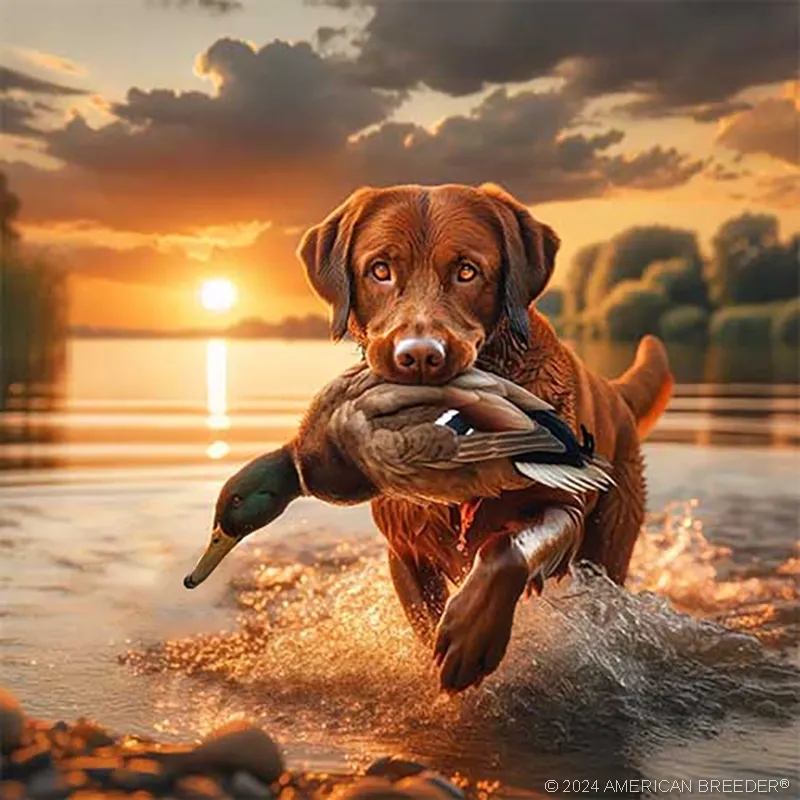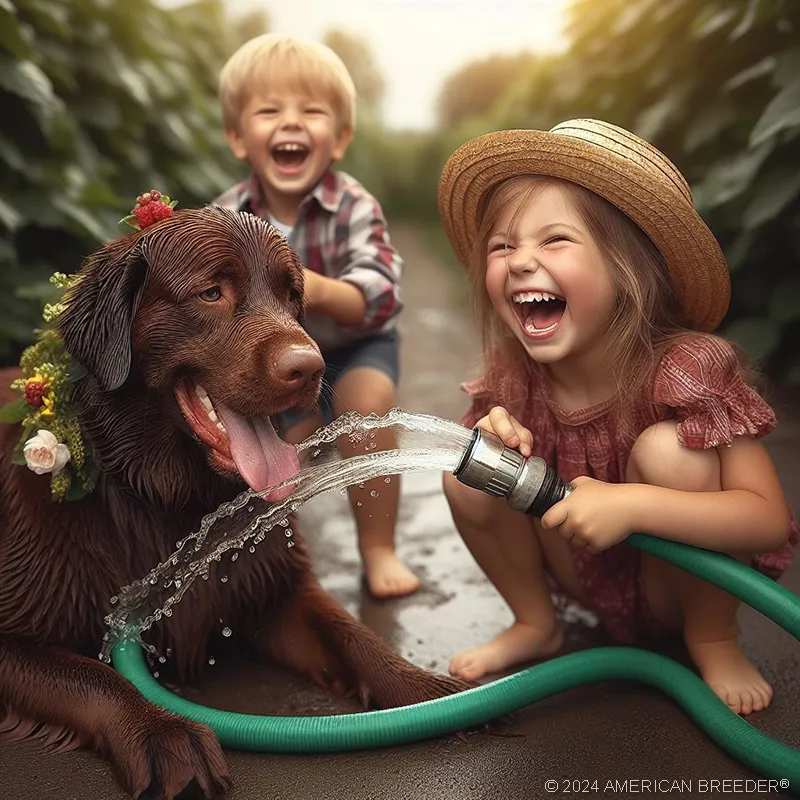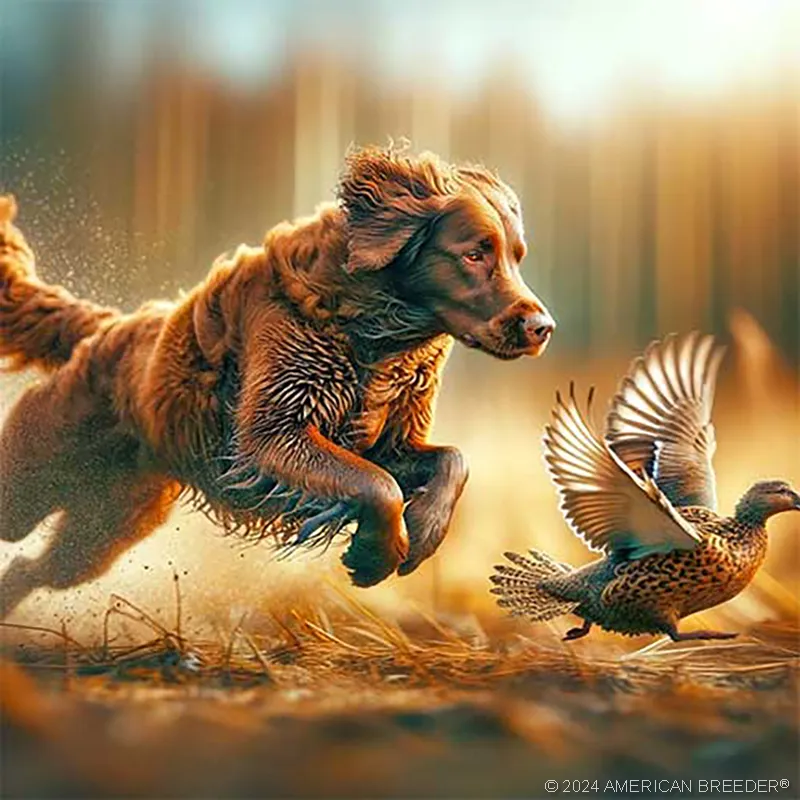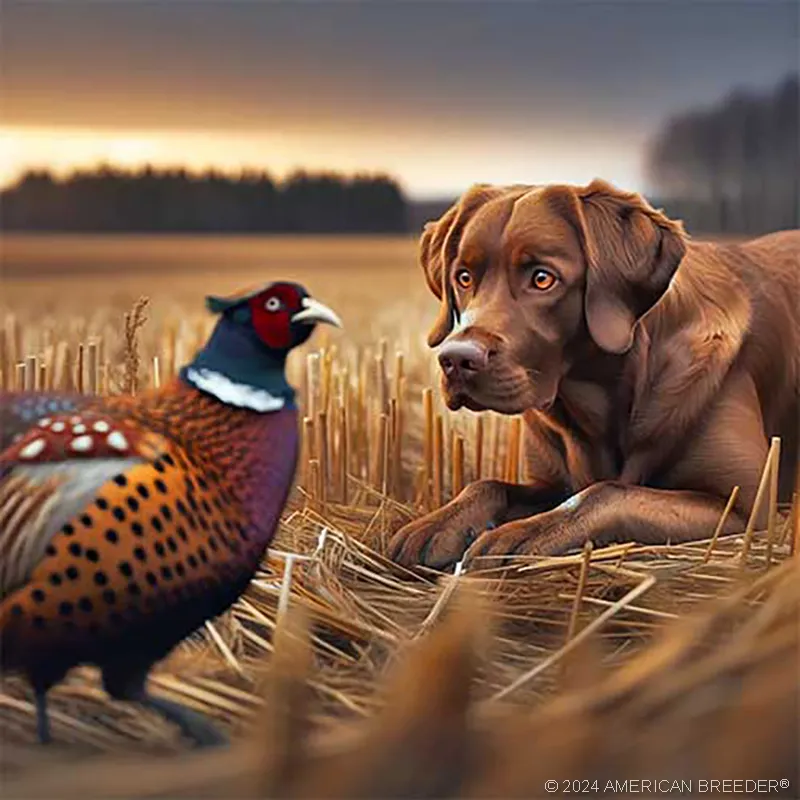Chesapeake Bay Retriever: Intelligent, Loyal, and Full of Energy
Introduction and Breed Background
 Welcome to the captivating world of the Chesapeake Bay Retriever Dog, an extraordinary breed with a rich history and a host of unique traits that make it a cherished companion for dog lovers around the globe. In this comprehensive guide, we will delve deep into the wonders of this incredible canine companion, unveiling its characteristics, history, temperament, and many other important details with utmost accuracy.
Welcome to the captivating world of the Chesapeake Bay Retriever Dog, an extraordinary breed with a rich history and a host of unique traits that make it a cherished companion for dog lovers around the globe. In this comprehensive guide, we will delve deep into the wonders of this incredible canine companion, unveiling its characteristics, history, temperament, and many other important details with utmost accuracy.
Brief Summary Description of the Chesapeake Bay Retriever Dog
The Chesapeake Bay Retriever, also lovingly known as the "Chessie," is a medium to large-sized sporting dog breed that hails from the United States. This remarkable breed was originally developed to excel in waterfowl hunting, particularly in the challenging conditions of the Chesapeake Bay region. Known for its impressive swimming abilities, strong retrieving skills, and unwavering loyalty, the Chesapeake Bay Retriever has become a beloved and versatile companion for both hunters and families alike.
Considerations Before Choosing a Chesapeake Bay Retriever Dog
Before welcoming a Chesapeake Bay Retriever into your home, it's essential to consider a few factors. This breed requires an active lifestyle, as its energy levels are notably high. Prospective owners should be prepared to provide ample exercise and mental stimulation to keep their Chessie content and well-behaved. Additionally, the Chesapeake Bay Retriever's protective nature means early socialization is vital to ensure a well-adjusted and friendly adult dog.
Nicknames for the Chesapeake Bay Retriever: With its distinctive appearance and exceptional retrieving abilities, the Chessie has earned amusing nicknames such as "Water Woofer" and "Bay Bullet." Aside from its popular nickname "Chessie," this breed is sometimes referred to as the Chesapeake, CBR, or Bay Ducking Dog.
Breed Background and History
Origin and Development of the Chesapeake Bay Retriever
The Chesapeake Bay Retriever's history traces back to the early 19th century along the Chesapeake Bay area, where local hunters sought a rugged, reliable, and water-resistant retriever to assist in their waterfowl hunting expeditions. The breed's ancestry is believed to be a result of crossing two Newfoundland dogs, the "St. John's Water Dog" (now extinct) from Newfoundland, and local retrievers or spaniels. Historical Significance or Cultural Relevance
Historical Significance or Cultural Relevance
The Chesapeake Bay Retriever's historical significance lies in its role as a dedicated and resilient hunting partner. Its extraordinary ability to withstand the harsh conditions of the Chesapeake Bay, such as icy waters and strong currents, earned it admiration among waterfowl hunters in the region. The breed's contribution to hunting and retrieving made it an integral part of the local culture, and its reputation spread across the United States.
Purpose or Original Use of the Chesapeake Bay Retriever
The Chesapeake Bay Retriever was initially bred to retrieve waterfowl for hunters, especially ducks and geese, from the frigid waters of the Chesapeake Bay. Their keen sense of smell, strong swimming skills, and natural affinity for water made them invaluable companions during hunting expeditions. They were often tasked with retrieving multiple downed birds in adverse conditions, a task they excelled at due to their tenacity and courage.
Kennel Clubs that Classify, Group, or Register the Chesapeake Bay Retriever
The American Kennel Club (AKC) classifies the Chesapeake Bay Retriever as part of the Sporting Group, a category that includes other exceptional hunting breeds. The breed's standard was officially recognized by the AKC in 1885, solidifying its status as a well-established and esteemed breed among canine enthusiasts.
Appearance
Size, Weight, Activity Level, and Physical Appearance
The Chesapeake Bay Retriever is a medium to large-sized dog, with males typically being larger and heavier than females. Adult males stand around 23-26 inches at the shoulder, and females are slightly smaller at 21-24 inches. In terms of weight, males weigh between 65-80 pounds, while females weigh between 55-70 pounds.
With a well-muscled, sturdy frame, and a strong neck and shoulders, the Chesapeake Bay Retriever exudes power and athleticism. Their webbed feet and waterproof double coat equip them for aquatic pursuits, making them exceptional swimmers and retrievers. Their eyes, which range in color from amber to yellowish, portray intelligence and determination, while their expressive and alert ears add to their engaging appearance. Coat Type, Color Variations, and Patterns
Coat Type, Color Variations, and Patterns
The Chesapeake Bay Retriever's coat is a remarkable feature that plays a significant role in its hunting capabilities. The breed sports a dense, waterproof double coat, with a short, harsh outer coat and a soft, insulating undercoat. This coat texture allows them to withstand cold waters and harsh weather conditions.
The Chessie's coat colors can vary and include various shades of brown, sedge, and deadgrass. Their coat may also exhibit tan points on the face, chest, and legs, further accentuating their distinctive appearance. While white markings on the chest, toes, or belly are acceptable, excessive white is considered undesirable in the breed standard.
Distinctive Features or Markings
One of the Chesapeake Bay Retriever's most unique and distinctive features is its distinctive coat texture and water-resistant properties. Their coat appears somewhat oily, enabling them to repel water effectively while retrieving from the water. Their webbed feet, another remarkable characteristic, provide powerful propulsion during swimming, making them unparalleled waterfowl retrievers.
Another defining feature is their striking amber to yellow eyes, which contribute to their keen and intelligent expression. Additionally, the Chessie's strong and muscular build showcases their agility and endurance, traits that make them exceptional hunting partners.
Average Litter Size for the Chesapeake Bay Retriever
The Chesapeake Bay Retriever typically has a moderate litter size, with litters usually consisting of 6 to 8 puppies. However, individual litters can vary, and responsible breeders take great care in ensuring the health and well-being of both the dam and her puppies during the breeding process.
Temperament and Personality
Typical Temperament Traits and Behavior Tendencies
The Chesapeake Bay Retriever is renowned for its loyal, affectionate, and protective nature. This breed forms strong bonds with its family and is known to be a devoted and loving companion. They are particularly devoted to their primary caregiver, making them exceptional family dogs.
In addition to their loyalty, Chessies possess a remarkable work ethic and intelligence. These traits, combined with their strong retrieving instincts, make them eager learners and excellent working dogs. Their protective instincts also mean they will fiercely guard their loved ones, making them reliable watchdogs. Energy Levels and Activity Requirements
Energy Levels and Activity Requirements
As a sporting breed with a history of hunting and retrieving, the Chesapeake Bay Retriever is highly active and requires plenty of physical and mental stimulation. They thrive in active households that can provide ample opportunities for exercise and play. A Chessie that lacks sufficient exercise may become bored and exhibit undesirable behaviors.
Regular outdoor activities such as long walks, hikes, swimming, or retrieving games are essential to keep this energetic breed physically and mentally satisfied. Engaging them in dog sports or competitive activities, such as agility, dock diving, or obedience trials, can further channel their energy and provide mental stimulation. Their love for water makes trips to the beach or a nearby lake an absolute delight for both owner and dog.
Compatibility with Different Lifestyles and Family Dynamics
The Chesapeake Bay Retriever's adaptability allows them to thrive in a variety of lifestyles and family dynamics. They can be equally content in a bustling household with children and other pets or in a quieter setting with a single owner. However, potential owners must ensure that they can meet the breed's exercise needs and provide consistent training and socialization.
Their protective and loyal nature makes them great companions for families with children, as they often form strong bonds with their young human counterparts. With proper socialization from a young age, Chessies can also get along well with other pets in the household.
List of Typical Behavior Issues:
Aggression and Biting: While Chesapeake Bay Retrievers are not inherently aggressive, poor socialization or inadequate training can lead to behavioral issues. Early and consistent training is essential to address any potential aggression or biting tendencies. Excessive Barking: As alert and protective dogs, Chesapeake Bay Retrievers may bark to alert their owners of potential intruders or stimuli. Proper training can help manage excessive barking and encourage appropriate behavior.
Excessive Barking: As alert and protective dogs, Chesapeake Bay Retrievers may bark to alert their owners of potential intruders or stimuli. Proper training can help manage excessive barking and encourage appropriate behavior.
Digging Behavior: This breed's history as a hunting dog with a love for retrieving can sometimes manifest as digging behavior in the backyard. Ensuring they have ample outlets for physical and mental stimulation can help curb this behavior.
Separation Anxiety: Their strong attachment to their family can lead to separation anxiety when left alone for extended periods. Crate training, interactive toys, and gradual departures can alleviate this issue.
Resource Guarding: Chessies may exhibit resource guarding behavior, particularly with their prized possessions like toys or food. Positive reinforcement training can help address this issue and encourage appropriate sharing.
Fear and Phobias: Improper socialization or traumatic experiences can lead to fear and phobias in Chesapeake Bay Retrievers. Early exposure to various environments and positive reinforcement during fearful situations can help build confidence.
Trainability and Intelligence
Trainability Level and Ease of Learning
Chesapeake Bay Retrievers are highly intelligent and eager to please, which makes them relatively easy to train. They excel in positive reinforcement-based training methods, responding well to praise, treats, and play as rewards for good behavior. Their strong work ethic and desire to please their owners make them quick learners in obedience and basic commands. Willingness to Please Their Owner
Willingness to Please Their Owner
With their innate desire to work alongside their human companions, Chesapeake Bay Retrievers are incredibly willing to please their owners. This eagerness to please and their high trainability make them excellent candidates for a variety of dog sports and activities, further strengthening their bond with their families.
Intelligence and Problem-Solving Abilities
Ranked among the more intelligent dog breeds, the Chesapeake Bay Retriever possesses problem-solving abilities that help them adapt to various situations. Their intelligence extends beyond basic obedience, making them versatile working dogs capable of tackling complex tasks with appropriate training and guidance.
Recommended Training Approaches and Techniques
Positive reinforcement training techniques work best with the Chesapeake Bay Retriever. Consistent praise, treats, and rewards for desired behaviors will foster a strong bond and encourage their willingness to learn. Harsh or punitive training methods should be avoided, as they can negatively impact this sensitive and loyal breed.
Training or Skills Best Suited for the Chesapeake Bay Retriever
Given their exceptional retrieving skills and love for water, training Chessies in waterfowl hunting or water retrievals can be a rewarding experience for both dog and owner. Additionally, their intelligence and agility make them well-suited for activities like agility, obedience trials, and dock diving.
Practical Considerations
Size of Sleeping Quarters Depending on Size
Due to their medium to large size, Chesapeake Bay Retrievers require ample sleeping quarters that accommodate their size comfortably. Providing a spacious dog bed or crate that allows them to stretch out and relax is essential for their well-being.
Typical Annual Veterinary Cost
The cost of veterinary care for a Chesapeake Bay Retriever can vary depending on the dog's age, health, and location. Annual check-ups, vaccinations, flea and tick prevention, and dental care are some of the routine expenses to consider.
Type of Grooming and Annual Cost
The Chesapeake Bay Retriever's waterproof coat requires regular grooming to maintain its water-resistant properties. Brushing their dense coat at least once a week helps remove loose hair and prevents matting. Occasional baths are necessary to keep them clean and fresh. Grooming costs may vary based on whether owners groom their Chessies at home or seek professional grooming services. Daily Exercise Needs and Requirements
Daily Exercise Needs and Requirements
Chesapeake Bay Retrievers are high-energy dogs that require daily exercise to stay physically and mentally healthy. A minimum of 60-90 minutes of vigorous exercise, such as long walks, jogging, or swimming, is necessary to prevent behavioral issues and ensure their well-being.
Level of Playfulness
The Chesapeake Bay Retriever's playful and exuberant nature brings joy to any household. Their love for retrieving games and water play can turn everyday activities into enjoyable bonding experiences with their owners.
Level of Intelligence
As one of the more intelligent dog breeds, the Chesapeake Bay Retriever has a remarkable ability to learn and adapt to new situations. This intelligence can be harnessed through training, interactive games, and activities that stimulate their minds.
Affection Level and Desired Attention
Chesapeake Bay Retrievers are known for their affectionate and loving nature toward their families. They thrive on human interaction and enjoy spending quality time with their owners, making them highly sociable and loyal companions.
Friendliness Toward Strangers
While Chessies are generally friendly and affectionate with their family members, they may exhibit a reserved or aloof demeanor with strangers. Proper socialization from an early age can help ensure they are well-mannered and approachable around new people.
Grooming Needs and Frequency
The Chesapeake Bay Retriever's coat requires regular grooming to maintain its water resistance and overall health. Brushing at least once a week helps remove loose hair and prevents matting. Occasional baths are necessary, especially after muddy outdoor activities.
Brushing: Weekly brushing is essential to remove loose hair and keep their coat clean and healthy.
Bathing: Chessies should be bathed as needed, typically every 6-8 weeks or when they become dirty.
Nail Trimming: Regular nail trimming is necessary to keep their nails at a comfortable length and prevent overgrowth.
Ear Cleaning: Regular ear cleaning is crucial to prevent ear infections, especially for dogs that spend time in the water.
Feeding Requirements and Dietary Considerations
Portion Sizes: The appropriate portion size for a Chesapeake Bay Retriever depends on their age, weight, activity level, and overall health. Consult with a veterinarian to determine the right portion size for your dog.
Feeding Schedule: Adult Chessies are usually fed twice a day, while puppies may require more frequent meals. Establishing a consistent feeding schedule helps regulate their digestion and prevents overeating.
Recommended Dog Food Brands/Types: Opt for high-quality dog food formulated for active breeds or working dogs. Look for dog foods that contain a balanced mix of protein, carbohydrates, and essential nutrients to support their energy needs and overall health.
Treats and Dietary Restrictions: Treats can be used as rewards during training sessions, but be mindful of the calorie content and avoid overindulging to prevent weight gain. Some Chessies may have food sensitivities or allergies, so it's essential to monitor their response to different treats and adjust accordingly.
Health and Care
Common Health Issues or Predispositions of the Chesapeake Bay Retriever
While the Chesapeake Bay Retriever is generally a healthy and robust breed, they may be prone to certain health issues. Some common conditions include hip dysplasia, elbow dysplasia, progressive retinal atrophy (PRA), and hypothyroidism. Responsible breeding practices, including health screenings, can help reduce the risk of inherited health problems. Allergies and Specific Dietary Considerations
Allergies and Specific Dietary Considerations
Like any breed, Chesapeake Bay Retrievers can develop allergies, which may manifest as skin irritations, itching, or gastrointestinal issues. Identifying and eliminating potential allergens from their diet can help alleviate symptoms and improve their overall well-being.
Lifespan and Longevity Expectations
On average, Chesapeake Bay Retrievers have a lifespan of 10 to 12 years. Providing regular veterinary check-ups, a balanced diet, ample exercise, and a loving home environment can contribute to a longer and healthier life for your furry companion.
Grooming Requirements Based on Coat Type and Size
The Chesapeake Bay Retriever's dense and waterproof coat requires regular grooming to keep it in top condition. Brushing their coat at least once a week helps remove loose hair and prevents matting. Regular baths and ear cleaning are also essential to maintain their overall hygiene.
Exercise Needs and Recommendations for Physical and Mental Stimulation
Chesapeake Bay Retrievers thrive on physical and mental stimulation, making daily exercise a necessity. Engaging them in activities that tap into their retrieving instincts, such as fetching games or swimming, helps fulfill their need for mental and physical challenges.
Nutrition and Feeding Guidelines
Feeding a balanced and nutritious diet is essential for the overall health and well-being of a Chesapeake Bay Retriever. Consult with a veterinarian to determine the appropriate portion sizes and dietary requirements based on their age, weight, and activity level.
Vaccination Schedule and Preventive Care
Following a proper vaccination schedule is crucial to protect the Chesapeake Bay Retriever from various diseases and ensure their long-term health. Core vaccines, such as rabies, distemper, parvovirus, and canine adenovirus, should be administered as recommended by a veterinarian. Non-core vaccines may also be recommended based on the dog's lifestyle and potential exposure to certain diseases.
Regular Health Check-ups and Vet Visits
Regular health check-ups are essential to monitor the Chesapeake Bay Retriever's overall health and catch any potential health issues early. Regular vet visits help detect and address health concerns, ensure their vaccinations are up-to-date, and receive guidance on proper nutrition and care.
Signs of Potential Health Problems and When to Seek Veterinary Attention
Being attentive to any changes in your Chesapeake Bay Retriever's behavior, appetite, or physical appearance is crucial in detecting potential health problems. If you notice any signs of distress, such as lethargy, loss of appetite, difficulty breathing, or abnormal behavior, it's essential to seek veterinary attention promptly.
Socialization and Compatibility
Interaction with Children, Other Pets, and Strangers
Chesapeake Bay Retrievers are generally good-natured and affectionate dogs, making them compatible with children and other pets when properly socialized. Early socialization helps them develop positive interactions with children and other animals, ensuring they are well-mannered and friendly in different situations. Socialization Needs and Tips for Proper Socialization
Socialization Needs and Tips for Proper Socialization
Early and consistent socialization is crucial for a Chesapeake Bay Retriever's well-rounded development. Expose them to various environments, people, and animals in a positive and controlled manner. Puppy socialization classes and supervised playdates can be beneficial in helping them become confident and friendly dogs.
Precautions or Considerations for Multi-Dog Households
When introducing a Chesapeake Bay Retriever to a multi-dog household, it's essential to proceed slowly and carefully. Supervised interactions and gradual introductions can help ensure a smooth and harmonious transition. While Chessies are generally friendly, individual personalities and dynamics among dogs can vary, so patience and supervision are key.
Level of Ease When It Comes to Training Chesapeake Bay Retriever
With their high intelligence and eagerness to please, Chesapeake Bay Retrievers generally respond well to training. However, some individuals may have an independent streak, making consistent and positive reinforcement training methods essential for success.
Playtime and Exercise with Other Dogs or Pets
Chessies enjoy playtime with other dogs or pets, especially if it involves retrieving games or swimming. Engaging them in social play with other dogs can provide mental and physical stimulation while fostering positive interactions.
Dog-Friendly Activities and Outings
Chesapeake Bay Retrievers thrive in outdoor activities, especially ones that involve water. Trips to the beach, lakeside adventures, or hiking trails are excellent options for dog-friendly activities. Chessies also enjoy participating in dog sports like agility, dock diving, and field trials, where they can showcase their natural abilities and skills.
Living Arrangements and Environment
 Suitability for Different Living Arrangements
Suitability for Different Living Arrangements
Chesapeake Bay Retrievers can adapt to various living arrangements, including houses with yards, apartments, or rural settings. However, their need for regular exercise and mental stimulation makes them best suited for homes with ample space and access to outdoor areas.
Space Requirements and Exercise Options
Chessies require enough space to move around comfortably, especially considering their medium to large size and high energy levels. A securely fenced yard provides them with a safe space to play and engage in retrieving games.
Climate Considerations and Adaptability
Their dense and water-resistant coat allows Chesapeake Bay Retrievers to adapt to various climates. However, they are more comfortable in cooler temperatures, and owners should take precautions to prevent heat-related issues during hot weather.
Recommended Yard Size for Chesapeake Bay Retrievers
While there is no one-size-fits-all yard size for Chesapeake Bay Retrievers, a moderately sized yard with room to run and play is ideal. Chessies benefit from regular exercise and outdoor play, so a yard that allows them to engage in their favorite activities is beneficial.
Ideal Living Conditions and Environment
Chesapeake Bay Retrievers thrive in an environment that allows them to fulfill their natural instincts, such as retrieving and swimming. Living near bodies of water, such as lakes or ponds, can be particularly enjoyable for this water-loving breed.
Training and Obedience
Basic Obedience Training and Commands
Basic obedience training is essential for all dogs, including Chesapeake Bay Retrievers. Teaching commands like sit, stay, come, and heel provides the foundation for a well-behaved and well-mannered dog.
Advanced Training or Specialized Activities Suited for Chesapeake Bay Retrievers
Given their excellent retrieving abilities and intelligence, Chesapeake Bay Retrievers excel in advanced training and specialized activities. They are often used in waterfowl hunting, search and rescue, and competitive dog sports like agility and dock diving.
Behavioral Challenges or Specific Training Considerations
As with any breed, Chesapeake Bay Retrievers may face certain behavioral challenges. Proper socialization from an early age can help prevent fearfulness or timidity, and consistent training is necessary to address any undesirable behaviors.
House Training and Potty Training Tips
House training should begin as soon as the Chesapeake Bay Retriever puppy enters its new home. Establishing a consistent routine for potty breaks and offering positive reinforcement for successful elimination helps them learn quickly.
Leash Training and Walking Etiquette
Leash training is vital to ensure that Chesapeake Bay Retrievers walk calmly and obediently on a leash. Consistent practice and positive reinforcement will help them develop good walking etiquette, making walks more enjoyable for both dog and owner.
Exercise and Activity
 Daily Exercise Needs and Recommendations
Daily Exercise Needs and Recommendations
Chesapeake Bay Retrievers are a high-energy breed that requires daily exercise to stay physically and mentally healthy. A combination of walks, playtime, and retrieving games is essential to meet their exercise needs.
Mental Stimulation Activities and Games
In addition to physical exercise, mental stimulation is crucial for Chesapeake Bay Retrievers. Engaging their minds through interactive games, puzzle toys, and training sessions helps prevent boredom and promotes a well-balanced and content dog.
Exercise Routines and Activity Ideas
Creating a varied exercise routine keeps Chessies engaged and motivated. Incorporate activities like swimming, hiking, fetch, and agility training to provide a stimulating and fun-filled daily routine.
Energy Outlets for High-Energy Breeds
For high-energy breeds like the Chesapeake Bay Retriever, providing various energy outlets is essential. Daily play sessions, regular walks, and participation in dog sports or activities that align with their natural instincts keep them happy and fulfilled.
Financial Planning
Typical Price Range for Purchasing a Chesapeake Bay Retriever from Reputable Breeders
The cost of purchasing a Chesapeake Bay Retriever from reputable breeders may vary based on location, breeder reputation, and the dog's pedigree. On average, the price range for a Chessie puppy from a reputable breeder can be between $1,000 to $2,500.
Initial Costs (Adoption Fees or Purchase Price, Vaccinations, Spaying/Neutering, Microchipping)
Initial costs for bringing a Chesapeake Bay Retriever into the family include the adoption or purchase price, vaccinations, spaying or neutering (if not already done), and microchipping for identification purposes.
Ongoing Expenses (Food, Grooming, Veterinary Care, Training, Toys, and Supplies)
Ongoing expenses for owning a Chesapeake Bay Retriever include high-quality dog food, regular grooming, veterinary care, training classes or sessions, toys, and other necessary supplies.
Considerations for Pet Insurance or Budgeting for Unexpected Medical Costs
Pet insurance can provide financial protection in case of unexpected medical emergencies or accidents. Alternatively, budgeting for potential medical costs in a separate savings account ensures you can provide the best care for your Chessie should the need arise.
Options for Pet Care During Vacations or Travel
When planning vacations or travel, owners must consider pet care options for their Chesapeake Bay Retrievers. Trusted friends or family members, reputable pet sitters, or boarding facilities can provide care while you are away.
Overall Summary
Concise and Cohesive Summary of Key Details in Bullet-Point Format
The Chesapeake Bay Retriever is a versatile and hardworking breed originally developed for hunting and retrieving waterfowl.
They are known for their strong work ethic, intelligence, and affectionate nature.
Chessies require regular exercise, mental stimulation, and socialization to thrive in a family setting.
Early and consistent training is crucial to ensure they develop good manners and behavior.
Proper grooming, a balanced diet, and regular veterinary care are essential for their overall health and well-being. Highlight Interesting and Fun Facts about Chesapeake Bay Retrievers
Highlight Interesting and Fun Facts about Chesapeake Bay Retrievers
The Chesapeake Bay Retriever is the state dog of Maryland, where it was originally bred to work in the region's harsh and icy waters.
They are one of the few dog breeds with webbed feet, a feature that enhances their swimming abilities.
Chessies have a unique coat that consists of a dense, oily undercoat and a water-resistant outer coat, making them well-suited for water activities.
The breed's name comes from the Chesapeake Bay, where they were first developed and where they proved their excellent retrieving abilities.
They are known for their distinctive "otter" tail, which is thick and powerful, helping them maintain balance while swimming.
Capture the Breed's Unique Characteristics and Appeal
The Chesapeake Bay Retriever's unique characteristics make them an exceptional choice for active individuals and families. Their strong retrieving instincts and love for water activities set them apart from other breeds, making them ideal companions for outdoor enthusiasts and those living near bodies of water. Their intelligence, loyalty, and affectionate nature endear them to their owners, forming strong bonds and lasting friendships.
Create Excitement and Enthusiasm for Potential Dog Owners
For potential dog owners seeking a loyal, intelligent, and versatile canine companion, the Chesapeake Bay Retriever is an exciting choice. Their boundless energy and eagerness to please make them perfect partners for various activities and dog sports. With the right training, socialization, and care, they become loyal and devoted members of the family, bringing joy and adventure to their human counterparts.
Conclusion
In conclusion, the Chesapeake Bay Retriever is a remarkable and multifaceted breed with a rich history and unique set of traits. Their origins as working dogs have shaped their exceptional work ethic, intelligence, and retrieving abilities, making them invaluable companions for hunters and outdoor enthusiasts alike. As loving family dogs, they thrive in environments that provide ample opportunities for exercise, mental stimulation, and socialization.
To welcome a Chesapeake Bay Retriever into your home, consider the commitment and dedication required to meet their specific needs. Providing proper training, regular exercise, a balanced diet, and veterinary care ensures their well-being and happiness throughout their lives. Whether as hunting partners, therapy dogs, or loving family pets, Chessies bring joy, companionship, and a sense of adventure to those who embrace them as members of their families.
Embrace the wonder of the Chesapeake Bay Retriever and embark on a journey of loyalty, devotion, and lasting memories with this exceptional canine companion. As you navigate the intricacies of dog ownership, always remember to cherish the unique bond you share with your Chessie and create a loving, safe, and fulfilling life together.
Chesapeake Bay Retriever Dog Quick Reference Guide
Breed Background: Origin: United States | Breed Purpose: Waterfowl Retrieval | AKC Class: Sporting Group | Year Recognized by AKC: 1885
Appearance: Size: Medium to Large | Weight: 55-80 pounds | Coat Type: Double coat, short and dense | Colors & Patterns: Various shades of brown, sedge, or deadgrass | Distinctive Features: Webbed feet, muscular build, keen expression
Temperament: Energy Level: 4/5 | Friendliness to Pets: 3/5 | Friendliness to Strangers: 2/5 | Trainability: 4/5 | Playfulness: 3/5 | Frequent Barker: 2/5 | Chase Instincts: 5/5 | Sense of Smell: 5/5 | Drive to Hunt: 5/5
Health & Care: Health Issues: Hip Dysplasia, Eye Problems | Lifespan: 10-12 years | Grooming Difficulty: Moderate | Exercise Needs: High
Socialization: Interaction with Children: Good, Protective | Interaction with Pets: Can be dominant, early socialization is important | Interaction with Strangers: Reserved, wary of strangers | Ease of Training: Moderately easy
Suitable Living Arrangements: Apartment: No | House: Yes | Rural Area: Preferable | Yard Size Requirements: Medium to large yard needed
Training & Obedience: Trainability: 3/5 | Intelligence: 4/5 | Obedience: 3/5 | Problem-Solving: 4/5 | Easily Stimulated: 4/5 | Focus Level: 3/5 | Easily Distracted: 3/5
Financial Planning: Typical Price Range: $800 - $1500 | Initial Expenses: Vaccinations, spaying/neutering | Ongoing Annual Expenses: Food, grooming, vet visits
Breeding: Reproductive Maturity: 18-24 months | Litter Frequency: Once per year | Litter Size: 6-8 puppies | Stud Cost: $1000 - $2000 | Breeding Challenges: Finding suitable mates, caring for the litter.
Did You Enjoy this Article? Share it and Help Us Spread the Word!
If you found this article helpful, we'd appreciate it if you could share it with your friends or link to it from your website, blog, or group! You can also use the convenient social share tabs on the left side of the screen to instantly share this page to your social media feed. For more ways to support and promote the American Breeder Community, visit our Share & Promote Together page for social media posts and memes you can copy and share. Your support means the world to us!
Disclaimer: The information provided in this article is for general informational purposes only and does not constitute legal, medical, financial, or professional advice. While we strive for accuracy, we make no representations or warranties regarding the completeness, accuracy, reliability, or suitability of the information. Please consult with a professional before making decisions based on the content provided. American Breeder Inc. assumes no responsibility for any errors or omissions or for the results obtained from the use of this information.

